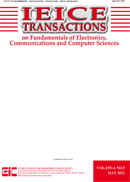Volume E107.A, Issue 5
Displaying 1-22 of 22 articles from this issue
- |<
- <
- 1
- >
- >|
Special Section on Analog Circuit Techniques and Related Topics
-
2024 Volume E107.A Issue 5 Pages 680
Published: May 01, 2024
Released on J-STAGE: May 01, 2024
Download PDF (272K) -
Article type: INVITED PAPER
2024 Volume E107.A Issue 5 Pages 681-699
Published: May 01, 2024
Released on J-STAGE: May 01, 2024
Advance online publication: December 07, 2023Download PDF (2681K) -
Implementing Optical Analog Computing and Electrooptic Hopfield Network by Silicon Photonic CircuitsArticle type: INVITED PAPER
2024 Volume E107.A Issue 5 Pages 700-708
Published: May 01, 2024
Released on J-STAGE: May 01, 2024
Advance online publication: January 05, 2024Download PDF (19071K) -
Article type: PAPER
2024 Volume E107.A Issue 5 Pages 709-718
Published: May 01, 2024
Released on J-STAGE: May 01, 2024
Advance online publication: November 02, 2023Download PDF (15998K) -
Article type: PAPER
2024 Volume E107.A Issue 5 Pages 719-726
Published: May 01, 2024
Released on J-STAGE: May 01, 2024
Advance online publication: November 07, 2023Download PDF (4913K) -
Article type: PAPER
2024 Volume E107.A Issue 5 Pages 727-740
Published: May 01, 2024
Released on J-STAGE: May 01, 2024
Advance online publication: November 24, 2023Download PDF (4488K) -
Article type: LETTER
2024 Volume E107.A Issue 5 Pages 741-745
Published: May 01, 2024
Released on J-STAGE: May 01, 2024
Advance online publication: December 05, 2023Download PDF (1373K) -
Article type: LETTER
2024 Volume E107.A Issue 5 Pages 746-750
Published: May 01, 2024
Released on J-STAGE: May 01, 2024
Advance online publication: December 05, 2023Download PDF (2562K)
Special Section on Mathematical Systems Science and its Applications
-
2024 Volume E107.A Issue 5 Pages 751
Published: May 01, 2024
Released on J-STAGE: May 01, 2024
Download PDF (91K) -
Article type: INVITED PAPER
2024 Volume E107.A Issue 5 Pages 752-761
Published: May 01, 2024
Released on J-STAGE: May 01, 2024
Advance online publication: October 02, 2023Download PDF (1541K) -
Article type: PAPER
2024 Volume E107.A Issue 5 Pages 762-769
Published: May 01, 2024
Released on J-STAGE: May 01, 2024
Advance online publication: January 18, 2024Download PDF (6886K) -
Article type: PAPER
2024 Volume E107.A Issue 5 Pages 770-778
Published: May 01, 2024
Released on J-STAGE: May 01, 2024
Advance online publication: November 10, 2023Download PDF (9732K) -
Article type: PAPER
2024 Volume E107.A Issue 5 Pages 779-785
Published: May 01, 2024
Released on J-STAGE: May 01, 2024
Advance online publication: September 26, 2023Download PDF (755K) -
Article type: PAPER
2024 Volume E107.A Issue 5 Pages 786-792
Published: May 01, 2024
Released on J-STAGE: May 01, 2024
Advance online publication: September 20, 2023Download PDF (3880K) -
Article type: PAPER
2024 Volume E107.A Issue 5 Pages 793-798
Published: May 01, 2024
Released on J-STAGE: May 01, 2024
Advance online publication: October 23, 2023Download PDF (1511K) -
Article type: PAPER
2024 Volume E107.A Issue 5 Pages 799-805
Published: May 01, 2024
Released on J-STAGE: May 01, 2024
Advance online publication: October 16, 2023Download PDF (1408K) -
Article type: PAPER
2024 Volume E107.A Issue 5 Pages 806-812
Published: May 01, 2024
Released on J-STAGE: May 01, 2024
Advance online publication: October 24, 2023Download PDF (3701K) -
Article type: PAPER
2024 Volume E107.A Issue 5 Pages 813-824
Published: May 01, 2024
Released on J-STAGE: May 01, 2024
Advance online publication: January 16, 2024Download PDF (27781K)
Regular Section
-
Article type: PAPER
Subject area: Cryptography and Information Security
2024 Volume E107.A Issue 5 Pages 825-835
Published: May 01, 2024
Released on J-STAGE: May 01, 2024
Advance online publication: August 23, 2023Download PDF (2819K) -
Article type: PAPER
Subject area: Multimedia Environment Technology
2024 Volume E107.A Issue 5 Pages 836-844
Published: May 01, 2024
Released on J-STAGE: May 01, 2024
Advance online publication: August 23, 2023Download PDF (1891K) -
Article type: LETTER
Subject area: Coding Theory
2024 Volume E107.A Issue 5 Pages 845-849
Published: May 01, 2024
Released on J-STAGE: May 01, 2024
Advance online publication: August 23, 2023Download PDF (502K) -
Article type: LETTER
Subject area: Communication Theory and Signals
2024 Volume E107.A Issue 5 Pages 850-854
Published: May 01, 2024
Released on J-STAGE: May 01, 2024
Advance online publication: August 23, 2023Download PDF (557K)
- |<
- <
- 1
- >
- >|
